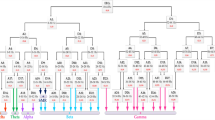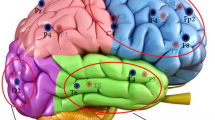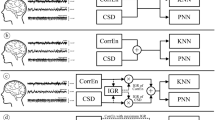Abstract
Electroencephalogram (EEG) has become a practical tool for monitoring and diagnosing pathological/psychological brain states. To date, an increasing number of investigations considered differences between brain dynamic of patients with schizophrenia and healthy controls. However, insufficient studies have been performed to provide an intelligent and accurate system that detects the schizophrenia using EEG signals. This paper concerns this issue by providing new feature-level fusion algorithms. Firstly, we analyze EEG dynamics using three well-known nonlinear measures, including complexity (Cx), Higuchi fractal dimension (HFD), and Lyapunov exponents (Lya). Next, we propose some innovative feature-level fusion strategies to combine the information of these indices. We evaluate the effect of the classifier parameter (σ) adjustment and the cross-validation partitioning criteria on classification accuracy. The performance of EEG classification using combined features was compared with the non-combined attributes. Experimental results showed higher classification accuracy when feature-level features were utilized, compared to when each feature was used individually or all fed to the classifier simultaneously. Using the proposed algorithm, the classification accuracy increased up to 100%. These results establish the suggested framework as a superior scheme compared to the state-of-the-art EEG schizophrenia diagnosis tool.





Similar content being viewed by others
References
Tschacher W, Giersch A, Friston K (2017) Embodiment and schizophrenia: a review of implications and applications. Schizophr Bull 43:745–753
Goshvarpour A, Goshvarpour A (2019) EEG spectral powers and source localization in depressing, sad, and fun music videos focusing on gender differences. Cogn Neurodyn 13(2):161–173
Goshvarpour A, Abbasi A, Goshvarpour A (2016) Combination of sLORETA and nonlinear coupling for emotional EEG source localization. Nonlinear Dyn Psychol Life Sci 20(3):353–368
Gardony AL, Eddy MD, Brunyé TT, Taylor HA (2017) Cognitive strategies in the mental rotation task revealed by EEG spectral power. Brain Cogn 118:1–18
Goshvarpour A, Goshvarpour A (2018) Automatic EEG classification during rapid serial visual presentation task by a novel method based on dual-tree complex wavelet transform and Poincare plot indices. Biomed Phys Eng Express 4:065022
Goshvarpour A, Rahati S, Goshvarpour A, Saadatian V (2012) Estimating the depth of meditation using electroencephalogram and heart rate signals. ZUMSJ 20(79):44–54 (in Persian)
Vytautas A, Misiūnas M, Meškauskas T, Samaitienė R (2019) Algorithm for automatic EEG classification according to the epilepsy type: benign focal childhood epilepsy and structural focal epilepsy. Biomed Signal Process Control 48:118–127
Kang J, Chen H, Li X, Li X (2019) EEG entropy analysis in autistic children. J Clin Neurosci 62:199–206
Karimui RY, Azadi S, Keshavarzi P (2019) The ADHD effect on the high-dimensional phase space trajectories of EEG signals. Chaos, Solitons Fractals 121:39–49
Dvey-Aharon Z, Fogelson N, Peled A, Intrator N (2015) Schizophrenia detection and classification by advanced analysis of EEG recordings using a single electrode approach. PLoS ONE 10(4):e0123033
Ibáñez-Molina AJ, Lozano V, Soriano MF et al (2018) EEG multiscale complexity in schizophrenia during picture naming. Front Physiol 9:1213
Li Y, Tong S, Liu D et al (2008) Abnormal EEG complexity in patients with schizophrenia and depression. Clin Neurophysiol 119:1232–1241
Hoffmann RE, Buchsbaum MS, Jensen RV et al (1996) Dimensional complexity of EEG waveforms in neuroleptic-free schizophrenic patients and normal control subjects. J Neuropsychiatry Clin Neurosci 8:436–441
Lee Y-J, Zhu Y-S, Xu Y-H et al (2001) Detection of non-linearity in the EEG of schizophrenic patients. Clin Neurophysiol 112:1288–1294
Sabeti M, Katebi S, Boostani R (2009) Entropy and complexity measures for EEG signal classification of schizophrenic and control participants. Artif Intell Med 47:263–274
Akar SA, Kara S, Latifoglu F, Bilgi V (2016) Analysis of the complexity measures in the EEG of schizophrenia patients. Int J Neural Syst 26:1650008
Roschke J, Aldenhoff JB (1993) Estimation of the dimensionality of sleep-EEG data in schizophrenics. Eur Arch Psychiatry Clin Neurosci 242:191–196
Fernández A, Gómez C, Hornero R, López-Ibor JJ (2013) Complexity and schizophrenia. Prog Neuropsychopharmacol Biol Psychiatry 45:267–276
Hornero R, Abasolo D, Jimeno N et al (2006) Variability, regularity and complexity of time series generated by schizophrenic patients and control subjects. IEEE Trans Biomed Eng 53(2):210–218
Boostani R, Sadatnezhad K, Sabeti M (2009) An efficient classifier to diagnose of schizophrenia based on the EEG signals. Expert Syst Appl 36(3):6492–6499
Sabeti M, Katebi SD, Boostani R, Price GW (2011) A new approach for EEG signal classification of schizophrenic and control participants. Expert Syst Appl 38(3):2063–2071
Shim M, Hwang H-J, Kim D-W, Lee S-H, Im C-H (2016) Machine-learning-based diagnosis of schizophrenia using combined sensor-level and source-level EEG features. Schizophr Res 176(2–3):314–319
Kim DJ, Jeong J, Chae JH et al (2000) An estimation of the first positive Lyapunov exponent of the EEG in patients with schizophrenia. Psychiatry Res 98:177–189
Kotini A, Anninos P (2002) Detection of non-linearity in schizophrenic patients using magnetoencephalography. Brain Topogr 15:107–113
Raghavendra BS, Dutt DN, Halahalli HN, John JP (2009) Complexity analysis of EEG in patients with schizophrenia using fractal dimension. Physiol Meas 30:795–808
Olejarczyk E, Jernajczyk W (2017) EEG in schizophrenia. RepOD. https://doi.org/10.18150/repod.0107441
Olejarczyk E, Jernajczyk W (2017) Graph-based analysis of brain connectivity in schizophrenia. PLoS ONE 12(11):e0188629
Lempel A, Ziv J (1976) On the complexity of finite sequences. IEEE Trans Inf Theory 22(1):75–81
Zhang XS, Zhu YS (1999) Detecting ventricular tachycardia and fibrillation by complexity measure. IEEE Trans Biomed Eng 46(5):548–555
Higuchi T (1988) Approach to an irregular time series on the basis of the fractal theory. Phys D 31(2):277–283
Rosenstein MT, Collins JJ, DeLuca CJ (1993) A practical method for calculating largest Lyapunov exponents from small data sets. Phys D 65:117–134
Mitchell TM (1997) Machine learning. McGraw-Hill, New York
Demuth H, Beale M (2000) Neural network toolbox. The MathWorks Inc., Natick
Goshvarpour A, Goshvarpour A (2019) Human identification using a new Matching Pursuit-based feature set of ECG. Comput Methods Programs Biomed 172:87–94
Goshvarpour A, Goshvarpour A (2018) A novel feature level fusion for HRV classification using correntropy and Cauchy-Schwarz divergence. J Med Syst 42:109
Goshvarpour A, Abbasi A, Goshvarpour A (2017) An accurate emotion recognition system using ECG and GSR signals and matching pursuit method. Biomed J 40:355–368
Goshvarpour A, Abbasi A, Goshvarpour A (2017) Indices from lagged Poincare plots of heart rate variability: an efficient nonlinear tool for emotion discrimination. Australas Phys Eng Sci Med 40(2):277–287
Goshvarpour A, Abbasi A, Goshvarpour A (2017) Fusion of heart rate variability and pulse rate variability for emotion recognition using lagged Poincare plots. Australas Phys Eng Sci Med 40:617–629
Goshvarpour A, Abbasi A, Goshvarpour A, Daneshvar S (2016) A novel signal-based fusion approach for accurate music emotion recognition. Biomed Eng Appl Basis Commun 28:1650040
Funding
This research did not receive any specific Grant from funding agencies in the public, commercial, or not-for-profit sectors.
Author information
Authors and Affiliations
Corresponding author
Ethics declarations
Conflict of interest
The authors declare that they have no conflict of interest.
Ethical approval
This article does not contain any studies with human participants performed by any of the authors.
Additional information
Publisher's Note
Springer Nature remains neutral with regard to jurisdictional claims in published maps and institutional affiliations.
Rights and permissions
About this article
Cite this article
Goshvarpour, A., Goshvarpour, A. Schizophrenia diagnosis using innovative EEG feature-level fusion schemes. Phys Eng Sci Med 43, 227–238 (2020). https://doi.org/10.1007/s13246-019-00839-1
Received:
Accepted:
Published:
Issue Date:
DOI: https://doi.org/10.1007/s13246-019-00839-1




